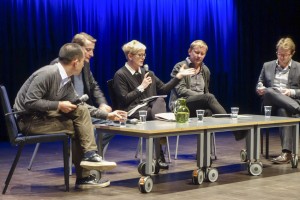The Design for Government (DfG) course consists of 25 talented and committed students in multidisciplinary teams, addressing real-world problems set forth by the Finnish government. The kick-off seminar attracted 150 participants from nine different ministries and other institutions, to discuss why traditional decision-making needs new ways of doing things. The…
The Design for Government (DfG) course consists of 25 talented and committed students in multidisciplinary teams, addressing real-world problems set forth by the Finnish government. The kick-off seminar attracted 150 participants from nine different ministries and other institutions, to discuss why traditional decision-making needs new ways of doing things. The students’ solutions will be presented to the Prime Minister’s Office and the Ministry of Agriculture and Forestry in May.
“We seriously lack the tools to take actions or plan proactively”, concluded Marco Steinberg, the founder of Snowcone and Haystack and former director of strategic design at the Finnish Innovation Fund Sitra. As was also pointed out by the author and organizer of DfG, Seungho Lee, the removal and re-installation of asphalt due to complaints by different citizen groups is an illustrative example of the reactive, not proactive, governance of today.
The growing inadequacy of policymaking and planning tools was one of the main motivations behind organizing the multidisciplinary Design for Government course. The application process for students was rigorous, designed to assess not only skills and experiences but also motivation. Now the enrolled twenty five students with various disciplinary backgrounds and work experience and nationalities have started working in teams.

“How do we separate the decisions that should be made in a bottom-up fashion with citizens from the ones that should be executed top-down?” was one of the questions discussed by the panel.
The six teams will work on problems commissioned by the Prime Minister’s Office and the Ministry of Agriculture and Forestry. One of them is the fruit and vegetable consumption of Finnish children that is currently below the recommended level of daily intake and lower than in any other EU member state. The aim is not to improve the efficiency of the current model, but rather to propose holistically new approaches: many of the institutions and operation models are created for yesterday’s world and do not function in today’s increasingly complex world.
Decision-making is changing fast
There is also a larger context addressed by the DfG seminar: yesterday’s ideas do not fit today’s world, and therefore our approach to governance and its toolkit must be constantly updated .
For instance, making cities sustainable sits in-between many silos of today’s government with different instruments and incentives, which often result in an inconsistent whole or duplicate resource allocation. “Ministries don’t often make much sense, since they spend their time on things that are no longer relevant”, said Steinberg.
Noteworthy is that a big part of the audience consisted of civil servants, including representatives from nine ministries and two city councils, many of them looking for new ideas and approaches. ”Hassle the bureaucrat, we want you to challenge our thinking”, said Kaisa Lähteenmäki-Smith from the Prime Minister’s office to the students at the event.
Policymaking wouldn’t have been discussed this way twenty years ago. “I can’t imagine a more fascinating time to be a designer, a public servant, or a politician”, outlined Steinberg. The culture and models of policy-making are changing. “The government is responding to the cultural change”, assured Lähteenmäki-Smith.
The end results of the course will be presented at House of the Estates (Säätytalo) on 26.5.2015 from 9 am to noon.
The Government Resolution on Comprehensive Reform of State Research Institutes and Research Funding of 5 September 2013 states that the preparation and implementation of social policies, and the related decision-making, should be based on well-researched information. Read more on this:
Working party proposes a new approach to Government policy
Government’s analysis, assesment and research activities
Interested of DfG?
Contact
Juha Leppänen, responsible researcher at Demos Helsinki
juha.leppanen@demoshelsinki.fi +358 407006585
Seungho Lee, author and responsible teacher of Design for Government at Aalto University
seungho.lee@aalto.fi +358 451291300
Read more:
Course website http://dfg-course.aalto.fi

